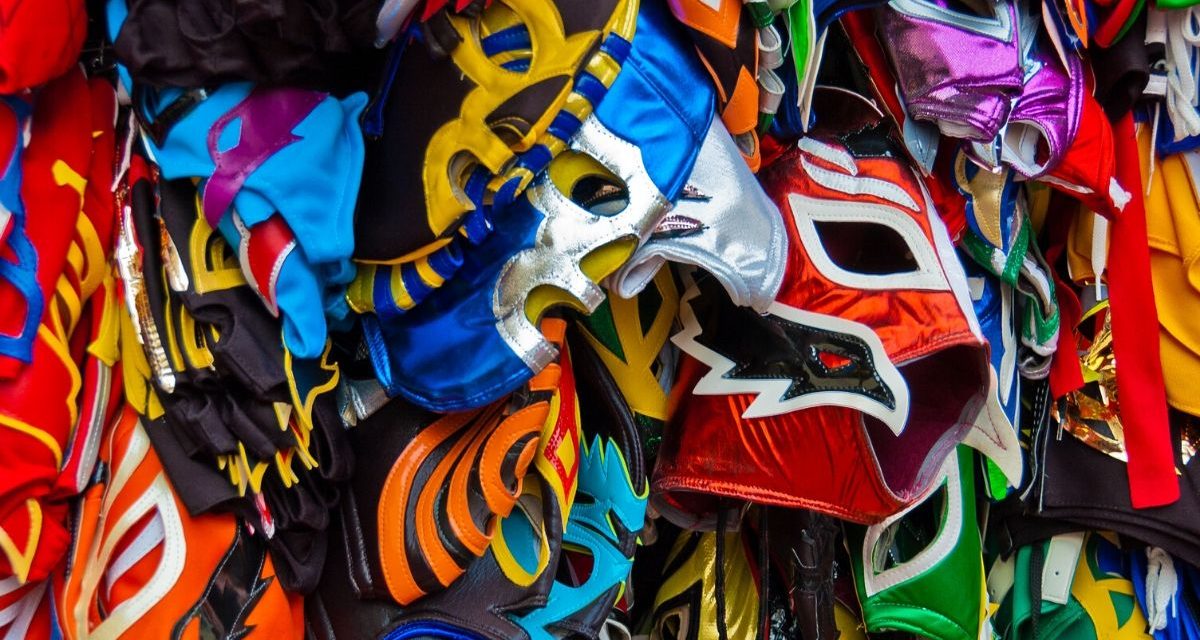Is a mask ever just a mask? For the list of professional wrestlers who have been privileged enough to wear one, it is as valuable as any World Championship.
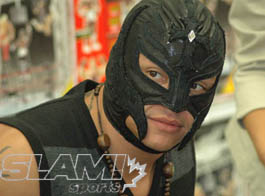
Rey Mysterio in one of his many masks. Photo by Mike Mastrandrea
“We all have split personalities. We all wear masks at some point in our careers,” WWE Superstar Rey Mysterio told the Houston Chronicle in a 2009 interview. “I literally wear a mask.”
Despite having different meanings to different people, the masks always add some mystique to a wrestler’s character. Everyone wonders who’s behind it, but nobody ever wants to see that identity revealed. It’s an idea that’s similar to the mystique of comic book heroes. The main difference is that all of the readers usually know the identity of the superheroes, while the wrestlers almost always do a good job of keeping themselves covered up.
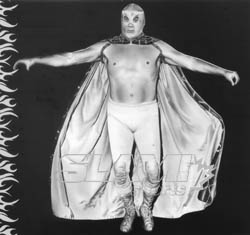
A drawing of El Santo by Antonio Pelayo.
When taking a look at the history of masked wrestlers in North America, perhaps one name stands out above the rest — the legendary El Santo. El Santo, which means “The Saint” in Spanish, was one of the most popular wrestlers of all time, and arguably the most famous luchador of all time. Though sources cannot confirm the exact date that Santo started wrestling, the earliest memories of him in the ring were in the late 1930s. Santo quickly rose to fame, and became a symbol of justice for the common man. His popularity increased when he started appearing in comic books and movies. Santo’s wrestling career would continue for almost five decades. He officially retired in 1982, just a week before his 65th birthday, and would then be succeeded by his son, El Hijo del Santo.
Dan Madigan, who was a former WWE writer and a huge fan of Lucha Libre, had a book published in 2007 called Mondo Lucha A Go-Go. When working for the WWE, Madigan remembers one night and one conversation in particular that really added to his respect for masked wrestlers.
“We were in New York City for Wrestlemania 20, and I was in the hotel restaurant trying to get something to eat. Chavo Guerrero Sr. came to join me and he had no idea that I was such a big Lucha fan. And then Eddie came and joined us, and they would tell me these stories of their father, Gory, in Mexico,” Madigan said. “Gory Guerrero was actually a tag team partner of El Santo. Eddie would tell me that Santo would come over to their house and even around the house, he wore the mask. It was part of who he was.”
Since then, Madigan has become a Lucha Libre expert. He actually went down to Mexico and did tremendous amounts of research for his book. He studied the differences between the American and Lucha styles of wrestling, and studied the masks to the point that he could teach about it. And in a way, he did.
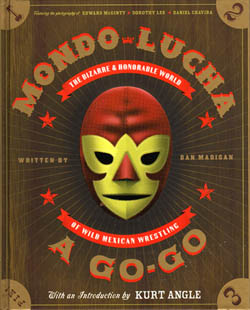
“Masked characters stand out because they have a visually compelling aesthetic, and have a natural mystery about them. A good masked wrestler can be a good storyteller, if he understands not just the role of physicality in a match, but the importance of ring psychology,” Madigan said. “The masks represent political change in Mexico. The rudos (heels) would be like the evil land owners or oppressive government officials; they symbolized what was wrong with Mexico during turbulent times. The technicos (babyfaces) were more like revolutionaries; the heroes who stood up for the people, and did the right thing. The fact that most technicos were hiding their true identities behind a mask, made the symbolizing more appealing to the masses, because the idea was that the hero could be anyone on a crowded street or in a packed arena; he was truly of the people. And of course, the same applies to the rudo. By having the identity hidden, the audience had the chance to fantasize that they were the ones in the ring at times. Ironically, in a surreal setting, the enmascarados (masked wrestlers) would bring elements of reality into the ring with them. Subconsciously, these characters were like cultural chess pieces, being played out in a game of us versus them. Consciously, they were the masked representation of what was good and bad in Mexican life.”
Masked wrestlers weren’t nearly as popular in the States as they were in Mexico. The Americans were represented by such masked wrestlers as Mr. X or the Masked Marvel, aliases used by countless wrestlers, Mr. Wrestling (Tim Woods), Mr. Wrestling II (Johnny Walker), Red River Jack (Bruiser Brody), The Masked Superstar (Bill Eadie), The Student (George “The Animal” Steele), The Assassin (Joe Hamilton), The original Super Zodiac (Gary Hart) and of course The Sensational, Intelligent Destroyer (Dick Beyer).
“I wear the mask all the time. When I drive down the road and if I’m in my home, I’ll take the mask off,” Beyer said. “But when I go out to pro wrestling events, I wear the mask. I’ve had several people tell me to take the mask off, because it’s all over. I say it’s not over. I wear it because people would not know who I am without it. So I wear it, so people know who I am.”
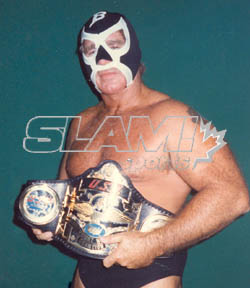
Bob Armstrong is “The Bullet.” Courtesy Chris Swisher
While Luchadores wear masks primarily to embrace their roots, the Americans wear masks for different reasons. Some of them use the mask as intimidation, while others wear it for the mystique. And in rare cases, the mask is worn for protection.
As every wrestler knows, injuries can happen. Bob Armstrong was doing bench presses one night, when the weight bench broke, and the bar landed on top of him, crushing his face. He underwent reconstructive surgery to repair the damage, but he insisted on continuing his wrestling career. However, he was forced to wear a protective mask in the ring, so as not to further injure himself. As tragic as the incident was, it actually turned out to be a blessing in disguise.
“It made me feel different, but I felt better about it,” Armstrong said. “It was kind of a double-edged sword, but the mask became my crutch; it was my cushion. I put a big B on the front of it, which stood for bullet, and I became Bullet Bob Armstrong. I actually became more popular with the mask than I ever was.”
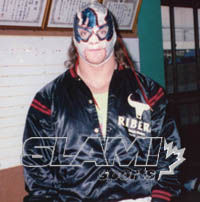
Chris Benoit as The Pegasus Kid in Japan. Photo by Mike Lano, WReaLano@aol.com
The popularity of the mask also extended north of the border into Canada. The late Owen Hart was always a great wrestler, but one can make the argument that he first got noticed, when competing under a mask, as The Blue Blazer. Chris Benoit was another Canadian who made a name for himself as The Pegasus Kid, while touring Japan. In the latter part of his career, John Tenta (Earthquake) competed under a mask as Golga of the Oddities. New Brunswick’s Don Jardine might have been the greatest heel masked man ever as The Spoiler.
The 1980 film Friday the 13th hit the box office like a bolt of lighting. It was only a matter of time before the wrestling business would capitalize on that success. So enter Jason the Terrible. The man behind that mask was Karl Moffatt. And as appropriate as it was for a Canadian to be wearing a hockey mask, Moffatt made it quite clear that he wore the mask, it did not wear him.
“You can’t sell with your face covered,” Moffatt said. “But it didn’t hinder my performance. If anything, it helped my career.”
The Jason character was over at the time. But that began to fade as the Friday the 13th franchise started getting stale. Nevertheless, it was a highlight of Moffatt’s career, and he enjoyed doing it.
“I didn’t know I was going to get over as well as I did, and it was a big deal at the time,” Moffatt said. “People started cheering me and I was concerned, because I didn’t want to be a face. It was much easier to be a heel.”
One of the great things about wearing a mask is that if people start to lose interest in the character, a wrestler can just lose the mask and take on a whole new gimmick altogether, without anybody knowing about it. Before The Undertaker rose from the dead, he competed as Texas Red, The Punisher and Master of Pain; three different masked men. Before Double A was the Enforcer, Arn Anderson was Super Olympia. And who can forget about Who? Jim Neidhart certainly could.
Other times, masks can be a big part of a storyline, with the hero having lost a loser leaves town match, only to return with his face hidden. Dusty Rhodes’ stint as the Midnight Rider is probably the most famous example of this, but countless others have done it, from Rocky Johnson, who was Sweet Ebony Diamond, to Hulk Hogan, who was Hulk Machine and later Mr. America. Or then there’s the Black Scorpion in WCW, where the bookers probably even didn’t know until the last minute that it would be Ric Flair in the full-body black outfit.
The Japanese wrestlers were no strangers to masks either. In fact some of the most popular Japanese stars in history wore masks. These included Jushin “Thunder” Liger, Ultimo Dragon, Tiger Mask I through IV and The Great Sasuke.
There was a period though when the masked men in the States became a bit of a joke. A lot of them were just made to look goofy by the promotions that they worked for. But that all changed in the mid ’90s when the Luchadores were introduced to the American fans for the first time. The moves they did in the ring, combined with the incredible and unique designs of each mask were fascinating to see.
“Masks are great visuals. They are literally something out of a comic book. Mil Mascaras used to come up with a unique look every night, as he always had a different mask,” Madigan said. “Bruce Wayne didn’t just become Batman overnight. He first went through all the trials and tribulations to get to that level. The hero and villain’s journey is one of an inner search. Once an enmascarado comes to terms with who he is and how the world will see him, then that is the first step in a metamorphosis from man to mystique.”
Some stars actually made a great living under a mask. The name Del Wilkes will undoubtedly have people scratching their heads, until they are reminded that he was The Patriot.
Christopher Daniels got himself over on his in-ring ability and microphone skills in both Ring of Honor and Impact Wrestling. But he had no problem wearing a mask a time or two in his career.
“The one thing about being under a mask is that you lose the facial expressions. You lose that aspect of telling a story,” Daniels said. “As long as I’ve been training, I’ve sort of learned to adapt and tell the story with my body language rather than facial expressions. It takes a while to get used to, just having that extra layer of clothing and just dealing with the fact that your body is sort of trapped inside. But after a while, it’s just something you cope with.”
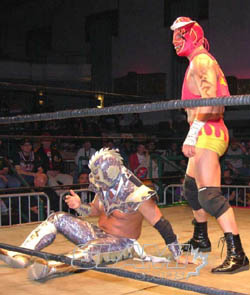
Curry Man looks to the crowd for approval as he comes in for the attack on a fallen Ultimo Dragon at the “Revolucha 3” show on Saturday, May 7, 2006 in Royal Oak, Mich. Photo by Chris Schramm
Daniels has competed as both Suicide and Curry Man and tries to make each character stand out in their own way. He may have even been able to breathe some new life into his career under the masks.
“The Curry Man character was really just a character that was based on a Japanese comic and I brought it to TNA just as sort of a break from such a serious character that the Fallen Angel is,” Daniels said. “Suicide was based on the video game, and it was just something that was just written into the video game and TNA just decided to see if that character could come to life, and become a character of importance that was in the storylines.”
There is no greater insult than for a Luchador to be unmasked by his opponent. The mask is almost like a trophy or a medal. Replica masks are sold in every sports arena in Mexico, as it’s a part of the Mexican heritage, so any Luchador who is unmasked, would feel like he is letting his family and countrymen down.
“Some of the Lucha magazines are very careful not to show the wrestlers without their masks. In the old day, there was an unwritten code of respect for the enmascarado. Photographers were careful not to show the true identity of the wrestlers. There was an understanding that masked wrestlers sold more magazines, so if the photographers started to show images of the enmascarados with their masks off or torn to the point you could make out who was underneath, then the popularity of some wrestlers may have waned and in doing so, sales of Lucha magazines may or may not go down,” Madigan said. “If a wrestler in Mexico City or Tijuana has his mask pulled off or torn, it would be seen by many in a matter of seconds. Technology has even crept into the secretive word of Lucha Libre.”
It was over 15 years ago that Rey Mysterio received his first standing ovation from the American wrestling fans. Who knew that he would be as popular today as he was back then? Mysterio was the successor of his uncle, the original Rey Mysterio, but he always tries to come up with different looks for himself, so as not to look identical.
“My masks and my colors and every single costume that I’ve worn at WrestleMania or special pay-per-views have been personally created by me,” Mysterio told writer Elliott Harris. “But don’t get me wrong; every now and then, I’ll get ideas from my daughter and my son. They’ll tell me, ‘Dad, you haven’t worn a Superman outfit or a Batman outfit. Why don’t you do Superman/Batman? They do tend to help me out every now and then.”
It’s amazing that the masked characters are still popular today. Rey Mysterio is one of the biggest stars in the wrestling business. And with Sin Cara (Mistico) joining him in the spotlight, maybe this can be the start of something great. According to numerous wrestling websites, the WWE has recently signed another masked man, Averno, and apparently has their eyes on a number of other Luchadores as well.
While the masks have different meanings to different wrestlers, one thing’s for sure: they will always catch the attention of wrestling fans worldwide.
